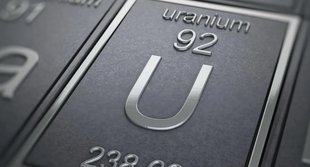6 Best-Performing Uranium ETFs: Why Invest in Them, Pros & Cons
With a diverse portfolio ranging from uranium miners to nuclear technology innovators, uranium ETFs provide a golden opportunity to ride the wave of the nuclear renaissance.
They track the uranium sector or a specific index of uranium stocks (like Cameco Corp), offering investors exposure to the market without owning physical uranium.
Let’s explore six high-potential uranium ETFs and the five factors you should assess before investing. We’ll also discuss the three pros and cons of investing in uranium ETFs and check out another attractive alternative asset – fine wine.
Finally, we’ll discover how you can build an enviable high-return wine portfolio through Vinovest.
Further reading
- Check out why Investing in Wine is Better Than Investing in Stocks.
- Consider investing in diverse assets through these 10 Alternative Investment Platforms.
6 Top-Performing Uranium ETFs to Explore in 2023
If you want to dip your feet into this market, here are the six high-potential uranium ETFs you should consider in 2023:
1. Global X Uranium ETF (NYSE: URA)
2. Sprott Uranium Miners ETF (NYSE: URNM)
3. VanEck Vectors Uranium+Nuclear Energy ETF (NYSE: NLR)
4. Horizons Global Uranium Index ETF (NYSE: HURA.TO)
5. First Trust Indxx Global Natural Resources Inc ETF (NASDAQ: FTRI)
6. ALPS Clean Energy ETF (NYSE: ACES)
1. Global X Uranium ETF (NYSE ARCA: URA)
The Global X Uranium ETF (URA), part of Global X Funds, is a widely recognized uranium-focused ETF that tracks the performance of the Solactive Global Uranium & Nuclear Components Index. It exposes investors to companies involved in uranium mining, exploration, and nuclear energy.
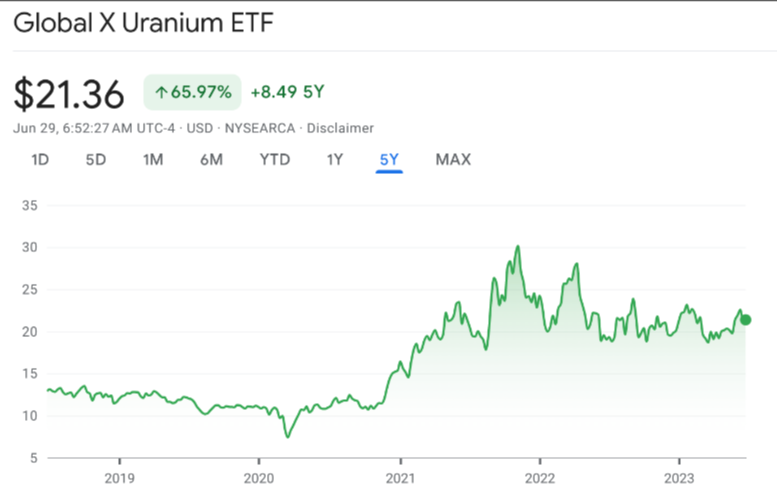
- YTD Daily Total Return: 6.37%
- Net Assets: $1.36 billion
- Net Expense Ratio: 0.69%
- Average Volume: 1,317K
- PE Ratio: 16.17
- Yield: 0.78%
2. Sprott Uranium Miners ETF (NYSE ARCA: URNM)
The Sprott Uranium Miners ETF (URA), a part of Sprott Asset Management, is an exchange traded fund focusing on uranium mining companies in the United States. It peaked in 2007 during a period of increased interest in nuclear energy.
However, the Sprott Physical Uranium Trust faced a decline in subsequent years due to events such as the 2011 Fukushima nuclear disaster and market dynamics affecting the net asset value of uranium. But the future outlook for the ETF is promising.
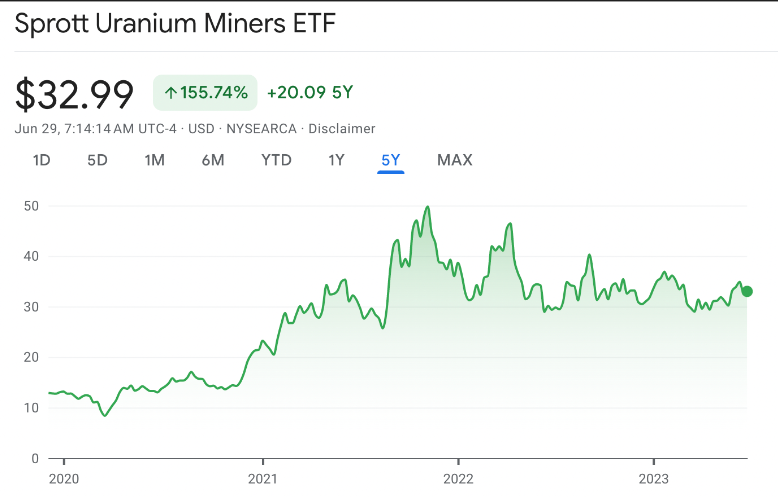
- YTD Daily Total Return: 3.94%
- Net Assets: $826.02 million
- Net Expense Ratio: 0.85%
- Average Volume: 278K
- PE Ratio: 17.36
- Yield: 0.00%
3. VanEck Vectors Uranium+Nuclear Energy ETF (NYSE ARCA: NLR)
The VanEck UraniumNuclear Energy ETF is an exchange traded fund that seeks to track the performance of the MVIS Global Uranium & Nuclear Energy Index.
The VanEck UraniumNuclear Energy ETF has faced challenges and periods of consolidation due to nuclear accidents, government policy shifts, and changes in public sentiment toward nuclear power.
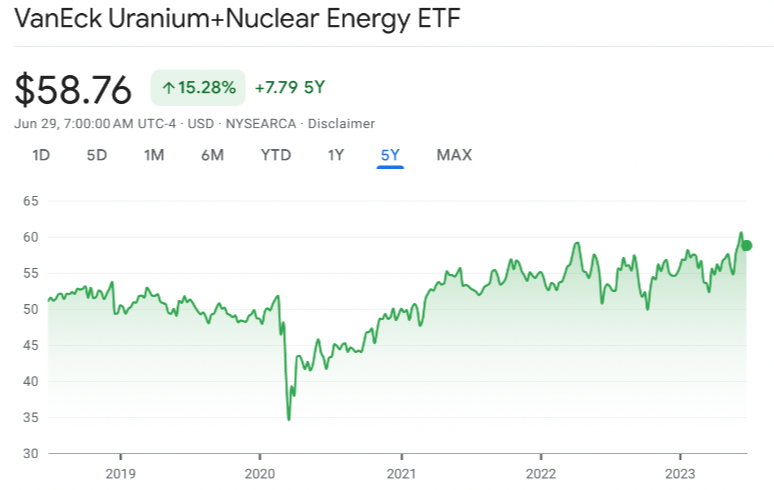
- YTD Daily Total Return: 7.05%
- Net Assets: $58 million
- Net Expense Ratio: 0.61%
- Average Volume: 4,917
- PE Ratio: 16.22
- Yield: 2.04%
4. Horizons Global Uranium Index ETF (NYSE ARCA: HURA.TO)
Horizons Global Uranium Index ETF is Canada’s first uranium ETF that follows the performance of the Solactive Global Uranium Pure-Play Index. It aims to provide exposure to the companies involved in the uranium exploration and mining process.
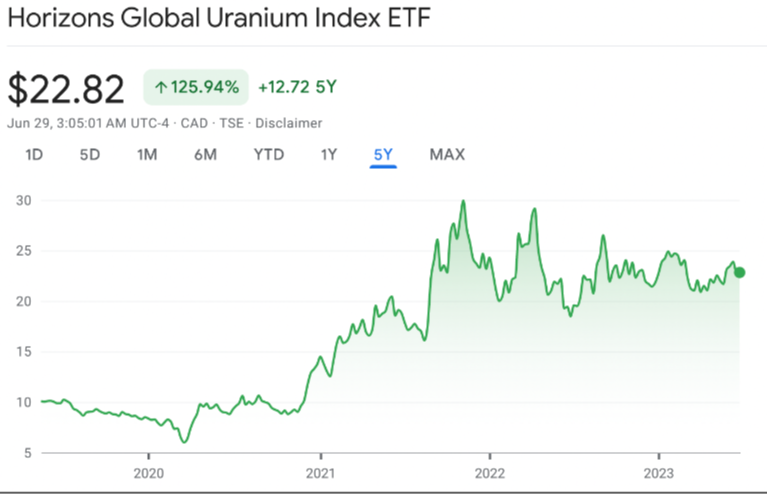
- YTD Daily Total Return: 4.68%
- Net Assets: $47.28 million
- Net Expense Ratio: 0.00%
- Average Volume: 1,875
PE Ratio: 15.31
- Yield: 1.41%
5. First Trust Indxx Global Natural Resources Inc ETF (NASDAQ: FTRI)
The First Trust Indxx Global Natural Resources Income ETF (FTRI) is an exchange-traded fund allowing investors to invest in global natural resources companies. The list includes a few fossil fuel and uranium mining companies from the United States.
The ETF tracks the performance of the Indxx Global Natural Resources Income Index.
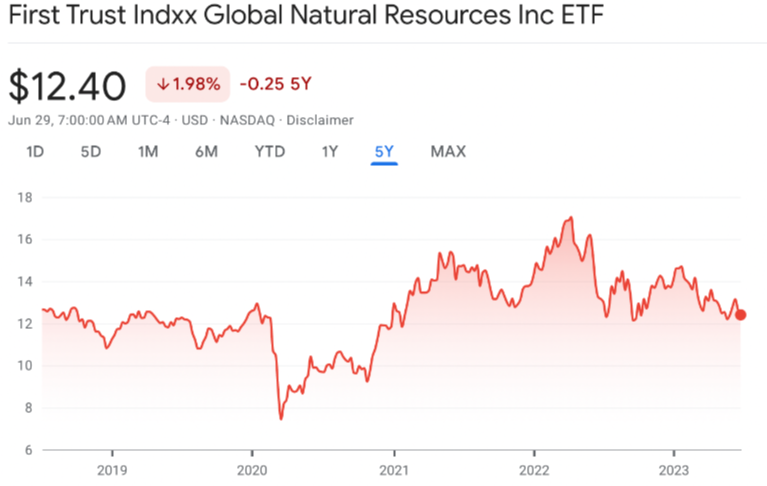
- YTD Daily Total Return: -6.46%
- Net Assets: $237.31 million
- Net Expense Ratio: 0.70%
- Average Volume: 145K
- PE Ratio: 5.63
- Yield: 9.04%
6. ALPS Clean Energy ETF (NYSE ARCA: ACES)
The ALPS Clean Energy ETF (ACES) is an exchange-traded fund focused on companies involved in the clean energy sector, including uranium mining. The ETF tracks the performance of the CIBC Atlas Clean Energy Index.
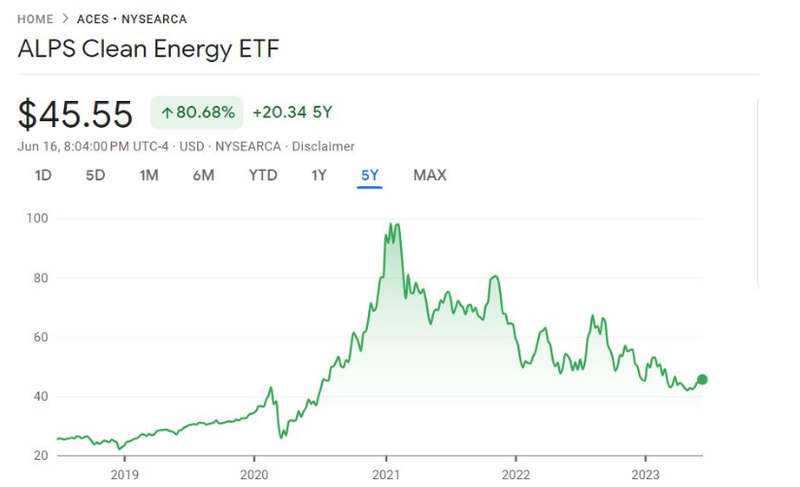
- YTD Daily Total Return: -4.15%
- Net Assets: $465.77 million
- Net Expense Ratio: 0.55%
- Average Volume: 84K
- PE Ratio: 16.39
- Yield: 1.13%
5 Factors to Consider When Investing in Uranium ETFs
Here are the five crucial factors to analyze before you invest in uranium ETFs:
1. Structure and Objective
When investing in uranium ETFs, assess their allocation to uranium-related stocks, diversification within the sector, and exposure to different uranium market segments. Consider whether the ETF or uranium stocks align with your investment objective and risk tolerance.
Your objective may be to seek long-term capital appreciation, income generation, or a combination of both.
2. Quant Ratings and Factor Grades
Quant ratings and factor grades can help investors evaluate the historical performance of uranium ETFs.
These ratings and grades are typically generated by quantitative models or algorithms that analyze specific factors and assign a rating or grade based on predefined criteria. Some factors, such as risk-adjusted returns and volatility, can give you an idea of how the ETF performed relative to its peers or benchmark index.
3. Expense Ratio and Management Fees
The expense ratio is the annual cost of owning the ETF and is expressed as a percentage of the fund's assets.
Lower expense ratios can improve your investment returns, all else being equal. Compare the expense ratios of different uranium ETFs and pick one that aligns with your cost expectations.
Besides the expense ratio, you should consider the management fees (deducted from the fund’s assets) before investing in uranium ETFs. Higher management fees directly reduce your investment returns, while lower fees provide a more attractive cost-benefit ratio.
4. Tracking Error and Index Replication
Tracking error represents the deviation between the ETF's returns and the returns of the underlying index or benchmark it aims to replicate. Lower tracking error indicates better tracking performance.
Analyze the ETF's ability to closely track its intended index and assess whether any deviations in stock price are acceptable to your investment strategy.
5. Fund Size and Assets under Management
An ETF’s fund size and assets under management (AUM) can indicate its popularity and investor confidence. A larger fund size may attract more investor interest and potential inflows.
This growth potential can result in increased investments and contribute to the expansion of the ETF's AUM.
3 Benefits of Investing in Uranium ETFs
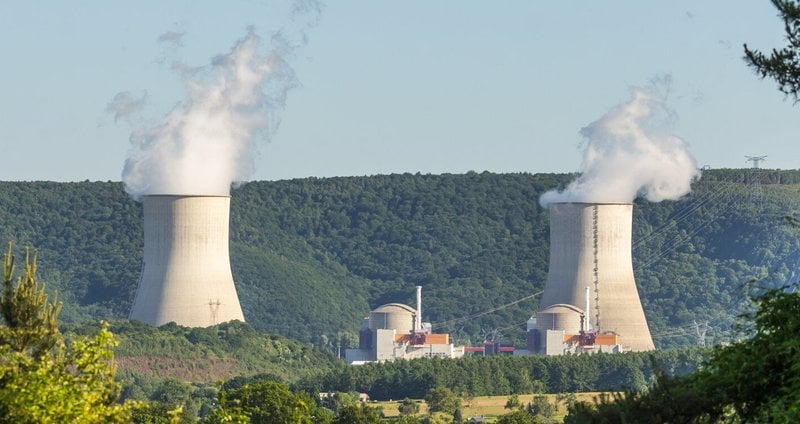
These are the three key benefits of investing in uranium ETFs:
1. Investment Portfolio Diversification
By adding exposure to the uranium market, you diversify your holdings, reducing portfolio risk.
This diversification can help balance your portfolio and potentially improve risk-adjusted returns.
2. Accessibility to the Uranium Market
Uranium ETFs typically hold a diversified basket of stocks of companies involved in various aspects of the uranium industry. Since these ETFs are traded on stock exchanges, you can easily buy and sell your share throughout the trading day.
Some Uranium ETFs are designed to track specific uranium-related indices. By investing in such ETF holdings that track such an index, you can gain broad exposure to the performance of the uranium prices represented by the index.
3. Lower Costs and Fees Compared to Other Investment Options
Since uranium ETFs track an index or hold a diversified basket of stocks, they can benefit from operational efficiencies, leading to lower costs.
A uranium ETF’s AUM increases with more investors, spreading fixed costs over a larger investor base and reducing the expense ratio.
3 Risks of Investing in Uranium ETFs
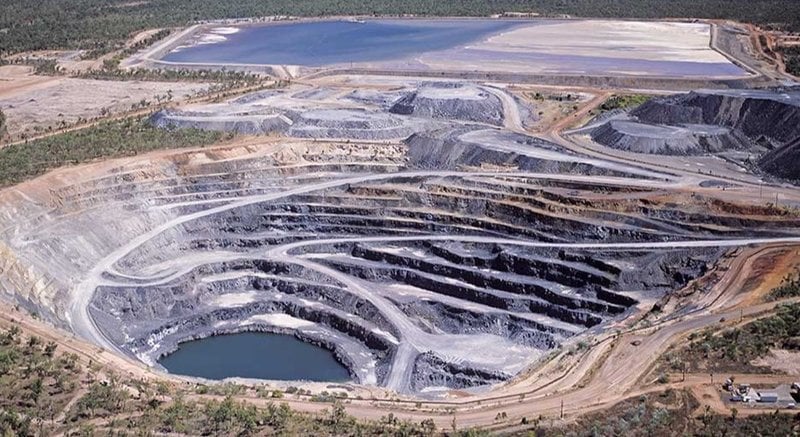
Placing your bets on uranium ETFs also comes with risks. You need to factor in these aspects:
1. Volatility and Price Fluctuations in the Uranium Market
Changes in uranium supply, including production levels, mine closures, or disruptions, can affect market dynamics, affecting ETF prices. Besides negative news, market expectations and sentiment regarding the future outlook for the nuclear power and uranium industry can influence investor behavior.
Such volatility undermines the uranium ETF’s performance, leading to a slump in its value.
2. Regulatory and Geopolitical Risks
Regulatory shifts like modifications in licensing requirements by the Financial Conduct Authority, safety standards, mining or waste disposal regulations, etc., impact the demand for uranium and the operation of nuclear power plants.
Additionally, political instability, conflicts, or changes in government policies related to nuclear power affect the demand and supply of uranium. For example, the imposition of trade barriers, tariffs, or export restrictions on uranium-producing countries disrupts the global uranium market and influences the performance of uranium holdings.
3. Market Liquidity and Trading Volume
When trading volume for uranium ETFs is low and market liquidity is limited, the bid-ask spreads in the ETF can widen, making it more costly for investors to buy or sell an ETF share.
It can result in increased transaction costs, reducing the overall return potential for investors.
Low trading volume and limited market liquidity also make the ETF holdings more susceptible to stock price impact from large trades.
Now, to build a well-rounded, balanced portfolio, you need to include stable assets that have minimal correlation with the markets too.
Your best bet?
Fine wine!
Fine Wine Investment: A Lucrative Alternative that Outpaces the Stock Market

Fine wine produced 20.54% returns in 2022, outpacing the S&P 500, which performed poorly with a return of -18.11%. Wine has also been comparatively less volatile (3.60%) than the S&P 500 stocks (21.16%) during the same period.
Here are some other benefits of wine investment:
- Wine investment depends only on supply and demand and has little to no correlation with market fluctuations.
- A top-notch vintage wine returns excellent gains over time, making it an excellent source of passive fixed income. For instance, if you invested $100 in fine wine in 1952, you would have received a yield of $420,000 in 2020, a 6,175% of average annual return.
- Online platforms like Vinovest have simplified wine investment, making it accessible to one and all.
- Certain cult vintage wines have performed exceedingly well at auction events, too, producing incredible results. For example, a 3-liter bottle of the 1945 Chateau Mouton-Rothschild was sold for an astounding $310,700 at a 1997 Christie's auction.
If you’re ready to start your wine investment journey, you can do so through Vinovest.
Invest in Top-Notch Wines Through Vinovest
Vinovest is an AI-driven wine investment platform that provides a simple and secure way to build an exceptional collection of profitable wines. The platform allows you to invest in some of the best wines from around the world.
The benefits of investing in Vinovest include:
- Low overall price: Vinovest lets you buy, store, sell, authenticate, and insure your bottle for a minimal fee of 2.5%.
- Hassle-free ownership: The platform authenticates, stores, and insures your wine for you, simplifying the ownership.
- No intermediaries: You don’t have to haggle with intermediaries since Vinovest sources your wine directly from wineries, wine exchanges, and auction events.
- Expert assistance: Vinovest's expert team of sommeliers guides you in picking the best high-return bottles for your portfolio.
Build a Diverse Portfolio of Uranium ETFs and Alternatives like Fine Wine
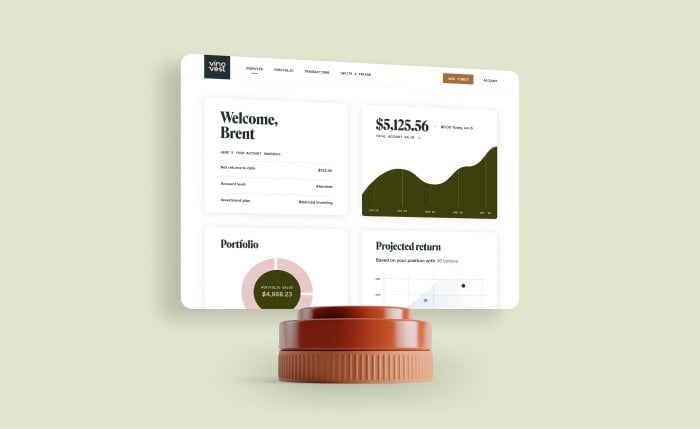
Since the stock market remains vulnerable to fluctuations, consider diversifying your portfolio with alternative assets like uranium ETFs.
But if you want to shore up your gains, earn a fixed income, and stay inflation resistant, consider an investment strategy involving fine wine.
Sign up with Vinovest today to build a high-return portfolio of world-class wines.
